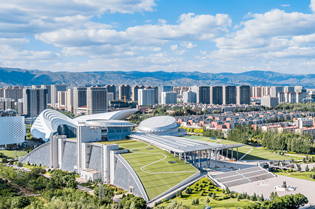From discovery to dominance: 75 years of development in Inner Mongolia's rare earth industry
Baotou in North China's Inner Mongolia autonomous region is making the most of its unique advantages to propel high-quality development in the rare earth industry.
China is the world's largest source and producer of rare earth elements, with Baotou being the epicenter, boasting 83.7 percent of the nation's and 37.8 percent of the world's rare earth reserves. The Bayan Obo in Baotou is the largest rare earth deposit in the world.
In the 1930s, Chinese geologists discovered rare earth elements in the Bayan Obo iron ore. In 1959, Baotou Steel Group produced the first batch of rare earth ferroalloy, marking the inception of China's rare earth industry.
In 1961, over 300 scientists were dispatched from steel research institutes nationwide to Baotou, kickstarting the development of China's rare earth technology.
In 1992, China's first high-tech zone named after rare earths was established in Baotou, heralding the industrialization of the sector.
Over the decades, Baotou has developed a comprehensive industrial chain, encompassing everything from mining and processing to the production of functional materials and end-use applications.
Seven of the top 10 national magnetic material companies are based in Baotou, with eight rare earth companies poised for public listing. The local conversion rate of refining and separating products in the city has reached 88 percent, with Baotou holding the second-largest capacity for permanent magnet materials and the largest for hydrogen storage, polishing, and alloy materials in China.
The city is now transitioning from a place that is rich in reserves to the home of a world-class industry.
Currently, Baotou is driving innovation to expand the rare earth application industry, focusing on five key new materials: rare earth permanent magnets, hydrogen storage, polishing, catalytic agents, and rare earth alloys.
Efforts are underway to develop the permanent magnet motor application industry. The city is accelerating the construction of a permanent magnet motor industrial park, fostering the development of high-end products like energy-efficient industrial motors, motors for new energy vehicles, and servo motors. With 30 companies setting up operations in the city, Baotou aims to achieve an annual output value of 5 billion yuan ($704.23 million).
In the polishing, catalysis, and optical functional materials sectors, Baotou plans to implement high-performance projects, including 3,000 metric tons of rare earth polishing materials and 6,000 tons of catalysts.
The city aims to industrialize projects like rare earth optical modification powders, targeting an annual capacity of 40,000 tons of polishing materials and 20,000 tons of catalytic materials.
For hydrogen storage materials, Baotou is advancing projects related to solid-state hydrogen storage forklift, expanding the commercial applications of nickel-hydrogen batteries in hydrogen fuel vehicles and refueling stations.
The city aims to build the largest rare earth hydrogen storage material base in China, with a projected annual capacity of 7,000 tons of hydrogen storage materials and 80,000 tons of alloy materials.
In October last year, the State Council issued a directive to promote the high-quality development of Inner Mongolia, designating Baotou as the nation's largest rare earth new material base and a global leader in rare earth applications.
Seizing this opportunity, Baotou is focused on constructing the "two rare earth bases", reshaping the industry's landscape.
Milestones include the successful trial production of medium and heavy rare earth metals, the commencement of a 100,000-ton rare earth green smelting project, the launch of a rare earth new material technology innovation center, and the full-scale construction of a rare earth permanent magnet motor industrial park.



 Print
Print Mail
Mail





